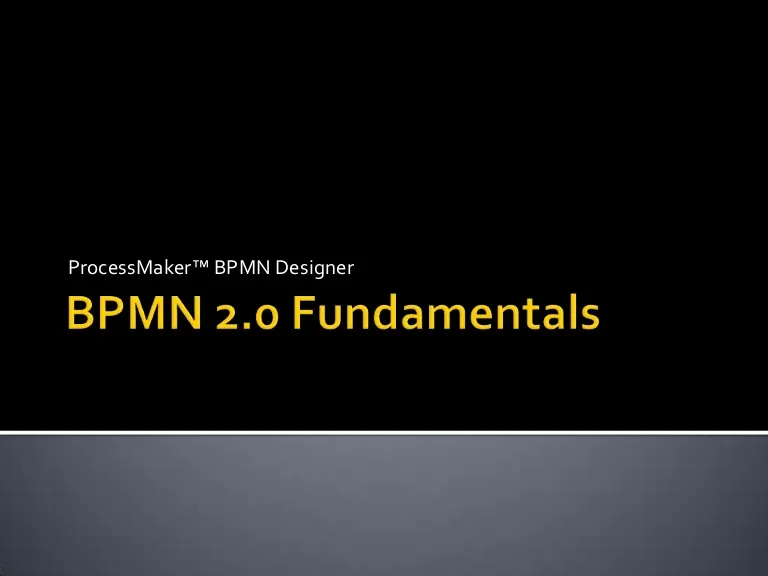BPMN 2.0 Fundamentals
Description
Little presentation about BPMN 2.0 basic elements
Transcript
ProcessMaker™ BPMN Designer What is BPMN?Business Process Model and Notation (BPMN) is a standard for business process modeling,and provides a graphical notation for specifying business processes based on aflowcharting technique.What is Business Process Modeling?Business Process Modeling is the activity of representing processes of an enterprise, sothat the current process may be analyzed and improved by other professionals.Why use BPMN to design processes?BPMN 2.0 is official way to design and share processes between almost all BPMS in themarket. BPMN is an OMG Standard. BPMN can represent Business Models by 4 kinds of diagrams: o Process Diagrams Represents regular flow between tasks, events and decision points to complete a process in the company. o Collaboration Diagrams Represents message flows or communication routes between process or entities like customers or partners. o Conversation Diagrams Represent groups of messages called “communications” and its relation between process and participants. o Choreography Diagrams Represent participant interaction between task and users or resources and the messages result of this interaction. Note: PM BPMN Designer supports Process and Collaboration diagram modeling. Process DiagramCollaboration Diagram Choreography DiagramConversation Diagram BPMN Project Process # 1 Flow Objects Data References Connection Objects Process # 2 Diagram # 1 Diagram # 2 Participants Data Objects Flow Objects Connecting Objects SequenceFlow MessageFlow Association Event Activity Gateway Data Objects & Artifacts SwimlanesDataObject DataStore Pool Group Lane Pool or Laneset is an elementrepresenting a process intoan organization or company.Lane is a representation of anarea or department of thecompany. Some times canrepresent a role into a processscope.Participant or Empty Pool is arepresentation of a process orentity that does not have anyaction within the process. An Event is something that “happens” during the courseof a Process or a Choreography. An Event affects theflow of the model and usually have a cause (Trigger) oran impact (Result).Event graphical representation is a circle.There’s 3 types of events: Start Events, IntermediateEvents and End Event.Intermediate Events can be used in regular processdiagrams and can be used as Boundary Events attachedto an activity.Start Events and Intermediate Events can be Interrupting andNon-interrupting. Activity is a generic term for work thatcompany performs in a Process. An ActivityCan be atomic or non-atomic.The type of activities that are part of theprocess are: Task and Sub-Process.A task can be differenced by markers thatrepresent its type or associated resource.Sub-Process can be Collapsed or Expanded,and can be differenced by the kind ofelements that join in: Sub-process,Transactions, Event Sub Process and CallActivities. A Gateway is used to control thedivergence and convergence ofsequence flows in a Process or in achoreography. =Gateway will determinebranching, forking, merging or joining.There’s 7 kinds of gateways differed byits internal marker:Exclusive, Inclusive, Parallel, Complex, Event-based, Parallel Event-basedand Exclusive Event-based. There’s 6 types or connection objects. Allof them are represented for a line. NormalSequence Flow can be Normal, Defaultand Conditional, and always have direction,source and target. DefaultMessage Flows are a type of connection objectthat is used to represent collaboration between Conditionaltwo process.Data Association is a line between a Data Object andAn element. Message Association Data Association BPMN 2.0 can represent Data in two ways: Data Storesand Data Objects.A Data Store provides a mechanism for Activities toretrieve or update stored information that will persistbeyond the scope of the Process. The same Data Storecan be visualized, through a Data Store Reference, inone or more places in the Process.Data Objects provide information about what Activitiesrequire to be performed and/or what they produce, DataObjects can represent a singular object or a collection ofobjects.Data Objects can be separated in Data Input and DataOutput only considering direction of the information. BPMN 2.0 considers 2 types of artifacts: Groups andText Annotations.A Group is a grouping of graphical elements thatare within the same Category. This type of groupingdoes not affect the Sequence Flows within theGroup. The Category name appears on the diagramas the group label. Categories can be used fordocumentation or analysis purposes. Groups areone way in which Categories of objects can bevisually displayed on the diagram.Text Annotations are a mechanism for a modeler toprovide additional text information for the reader ofa BPMN Diagram. Into collaboration diagrams there’s a main concept to consider: “A PARTICIPANT”. BPMN considers a participant an entity or process involved into a collaborative relation .Participants Object Management Group/Business Process ManagementInitiativewww.bpmn.orgDocuments Associated with Business Process Model andNotation (BPMN) Version 2.0http://www.omg.org/spec/BPMN/2.0/ Enrique Ponce de Leon (qennix) Development Team Leader – Colosa Inc. enrique@colosa.com – iam@qennix.com August, 2011
